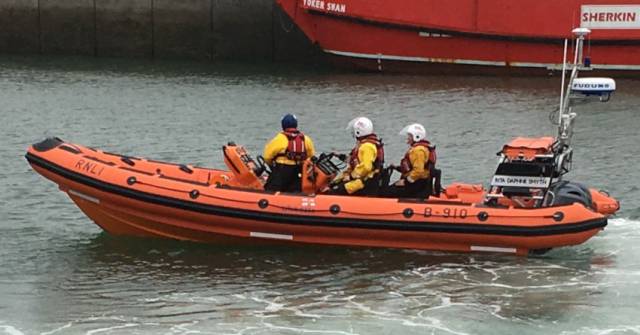#Lifeboats - Baltimore RNLI has welcomed its new Atlantic 85 class inshore lifeboat on service in the West Cork village.
The inshore lifeboat arrived at Baltimore lifeboat station on Thursday 13 September and replaces the Atlantic 75 class lifeboat, Patricia Jennings, which has been used to save lives at sea in Baltimore since 2016.
Last week saw the volunteer lifeboat crew undertake familiarisation training on the Rita Daphne Smyth, and the new inshore lifeboat officially went on service at Baltimore lifeboat station last Thursday evening (20 September) alongside the all-weather lifeboat Alan Massey.
The new lifeboat has been funded through a legacy from the late Rita Daphne Smyth, a native of Harrow in Middlesex, England, who was a supporter of the charity’s volunteers in saving lives at sea.
The Rita Daphne Smyth will be officially named at a special
ceremony and service of dedication.
In her two years in Baltimore, Patricia Jennings launched 21 times, with its volunteer lifeboat crew rescuing 17 people.
The new lifeboat has some advancement on its predecessor. The Atlantic 85 is 10m longer than the Atlantic 75 and allows room for four crew members onboard rather than three.
The lifeboat is powered by two 115hp engines and has a stronger hull and greater top speed of 35 knots. The added radar allows the crew to operate more effectively in poor visibility and there is also VHF direction-finding equipment.
The vessel has a manually operated self-righting mechanism which, combined with inversion-proofed engines, keeps the lifeboat operational even after capsize. The lifeboat can also be beached in an emergency without causing damage to its engines or steering gear.
The Atlantic 85, which was introduced to the RNLI fleet in 2005, also carries a full suite of communication and electronic navigation aids, as well as a searchlight, night-vision equipment and flares for night-time operations.
Baltimore RNLI lifeboat operations manager Tom Bushe said: “We are extremely grateful to Miss Smyth for the generous legacy donation which has funded our new lifeboat.
“As we welcome a new lifeboat, there is also a sense of nostalgia among us today too as we bid a fond farewell to Patricia Jennings who provided us with two great years of service.
“Patricia Jennings time here in Baltimore brought many people safely to shore and we hope her donor family will be just as proud as we are, of her many achievements.
“We are looking forward to being the custodians of this new lifeboat which will allow our volunteers to go on to rescue and save many more lives in the years to come.”































































